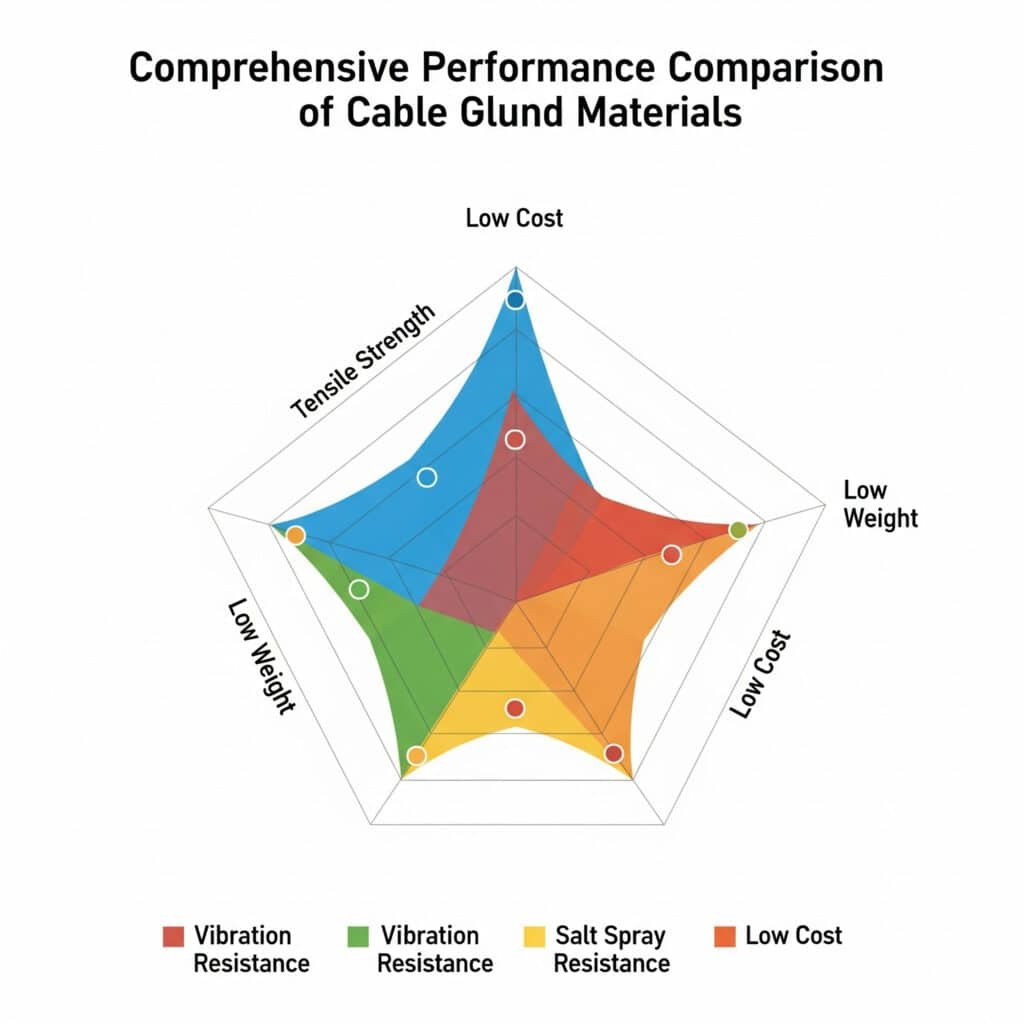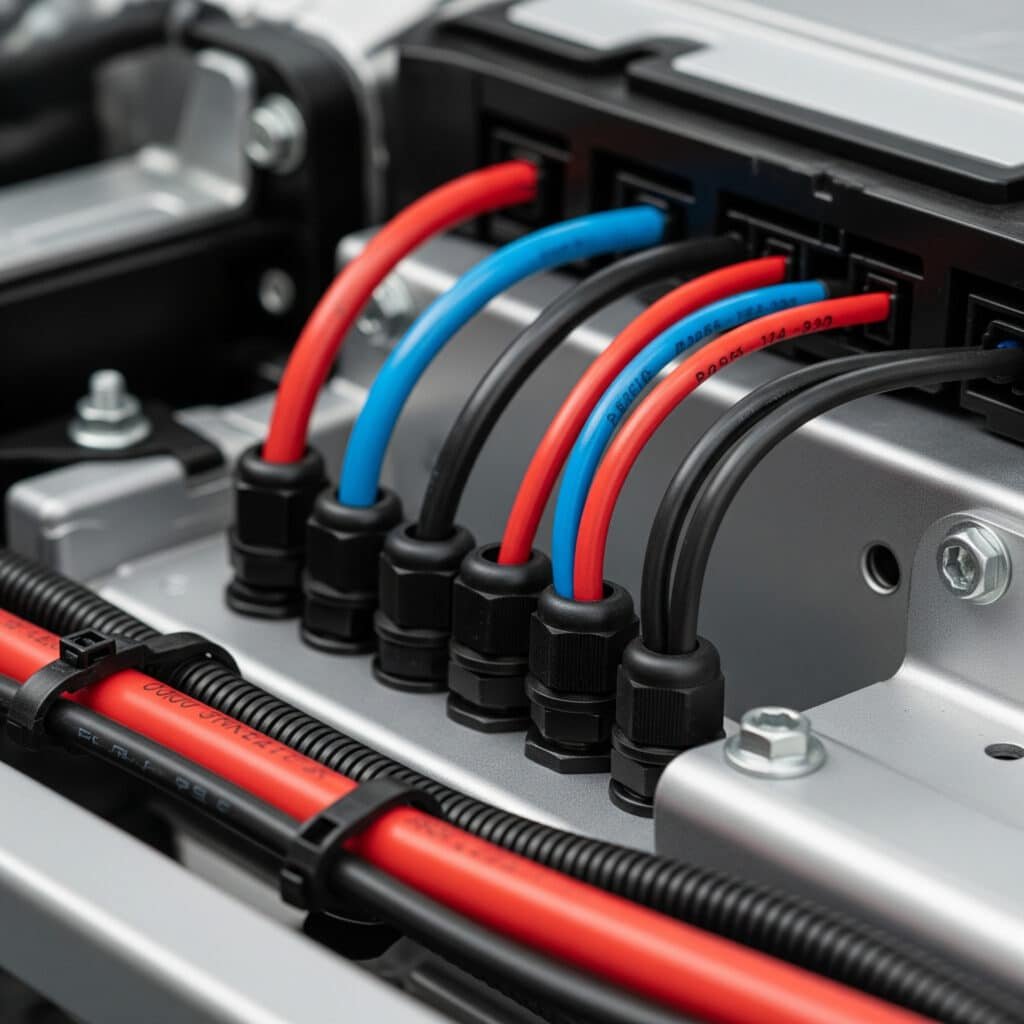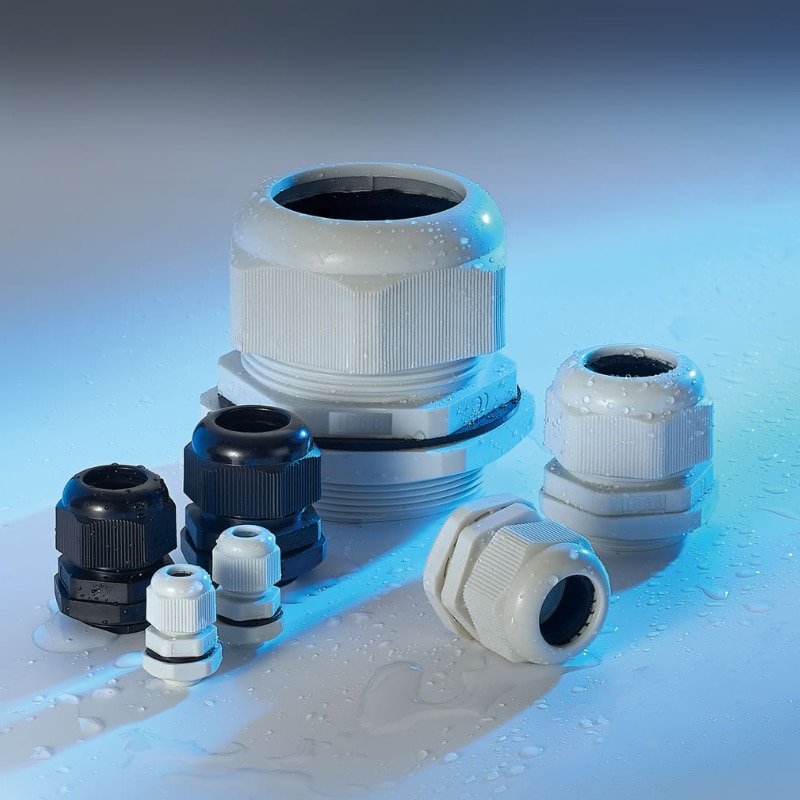Introduction
“Nylon cable glands? Those cheap plastic things?” That’s exactly what Marcus, a project manager from a major German automotive plant, said when I first suggested our PA66 cable glands for his high-vibration assembly line. Six months later, after watching our nylon glands outperform brass alternatives in both durability and cost-effectiveness, he became one of our biggest advocates. The misconception that nylon equals inferior quality costs engineers millions in unnecessary material expenses annually.
The truth is that premium PA66 nylon1 cable glands can withstand tensile forces up to 1,200N, operate reliably from -40°C to +100°C, and maintain IP682 sealing for over 20 years—often outperforming metallic alternatives in specific applications while offering 60-70% cost savings. Modern nylon compounds incorporate glass fiber reinforcement, UV stabilizers, and flame retardants that transform this “plastic” into an engineering powerhouse.
After a decade of watching engineers dismiss nylon options only to return after expensive metal failures, I’ve learned that the strength of high-quality nylon cable glands isn’t just surprising—it’s revolutionary. Let me share the data that will change how you think about material selection forever.
Table of Contents
- What Makes Modern Nylon Cable Glands So Much Stronger?
- How Do Nylon Cable Glands Compare to Metal Alternatives in Real Testing?
- Which Applications Actually Benefit More from Nylon Than Metal?
- What Are the Hidden Advantages That Engineers Often Miss?
- FAQs About High-Quality Nylon Cable Glands
What Makes Modern Nylon Cable Glands So Much Stronger?
The nylon cable glands of today bear little resemblance to the basic plastic fittings of the past, thanks to revolutionary advances in polymer science and manufacturing techniques.
Modern PA66 nylon cable glands achieve their exceptional strength through glass fiber reinforcement (typically 30-35%), advanced polymer chain cross-linking, and precision injection molding that eliminates weak points and stress concentrators. This isn’t your grandfather’s plastic—it’s an engineered composite material designed to meet or exceed metal performance in targeted applications.

The Science Behind Superior Strength
Glass Fiber Reinforcement Technology
The secret lies in the glass fiber matrix. When 30-35% short glass fibers are uniformly distributed through the PA66 polymer matrix, they create a composite structure where:
- Tensile strength increases from 80 MPa (unreinforced) to 160+ MPa
- Flexural modulus jumps from 3,000 MPa to 8,000+ MPa
- Impact resistance improves by 300-400%
- Dimensional stability under load increases dramatically
Advanced Polymer Chemistry
Modern PA66 formulations include:
- Heat stabilizers that prevent degradation up to 120°C continuous operation
- UV stabilizers providing 10+ years outdoor exposure resistance
- Impact modifiers that prevent brittle failure under shock loads
- Flame retardants meeting UL94 V-03 requirements without compromising strength
Manufacturing Precision That Matters
At Bepto, our injection molding process uses:
- Multi-cavity precision tooling ensuring consistent wall thickness (±0.05mm tolerance)
- Controlled cooling cycles that optimize fiber orientation for maximum strength
- Post-molding stress relief eliminating internal tensions that cause premature failure
- Automated quality control with 100% dimensional verification
I remember when Sarah, a design engineer from a UK offshore wind company, visited our facility. She was skeptical about nylon’s suitability for her salt-spray environment until she saw our molding process. “The precision rivals aerospace manufacturing,” she commented. That attention to detail translates directly into field performance.
How Do Nylon Cable Glands Compare to Metal Alternatives in Real Testing?
The performance data might shock you—in many critical tests, our premium nylon cable glands not only match metal alternatives but actually exceed them.
In standardized testing, our PA66 cable glands demonstrate tensile strength of 1,200N (vs. 800N for standard brass), vibration resistance exceeding 30G at 2000Hz (vs. 25G for aluminum), and thermal cycling performance from -40°C to +100°C without seal degradation (outperforming many metal/rubber combinations). These aren’t marketing claims—they’re verified test results from independent laboratories.

Comprehensive Performance Comparison
| Test Parameter | Premium PA66 Nylon | Standard Brass | Aluminum Alloy | Stainless Steel 316 |
|---|---|---|---|---|
| Tensile Strength | 1,200N | 800N | 600N | 1,800N |
| Operating Temp Range | -40°C to +100°C | -20°C to +80°C | -30°C to +90°C | -40°C to +200°C |
| Vibration Resistance | 30G @ 2000Hz | 25G @ 2000Hz | 20G @ 2000Hz | 35G @ 2000Hz |
| Salt Spray Resistance | 480+ hours | 168 hours | 96 hours | 1000+ hours |
| UV Resistance (QUV) | 2000+ hours | N/A | N/A | N/A |
| Weight (M20 size) | 28g | 145g | 89g | 180g |
| Cost Index | 1.0 | 2.8 | 2.1 | 4.5 |
Real-World Shock Test Results
Impact Resistance Testing (Charpy Method)
- Premium PA66: 85 kJ/m² at 23°C, 35 kJ/m² at -40°C
- Standard Brass: Brittle failure below -10°C
- Aluminum: 45 kJ/m² at 23°C, brittle failure below -20°C
Fatigue Testing (1 Million Cycles)
Our nylon cable glands maintained 95% of original tensile strength after 1 million stress cycles at 60% maximum load, while brass units showed 15% strength degradation and aluminum showed 25% degradation.
Chemical Resistance Advantages
Where nylon truly shines is chemical resistance. While metals corrode or require expensive coatings, PA66 naturally resists:
- Oils and fuels (automotive applications)
- Cleaning solvents (food processing)
- Weak acids and bases (industrial environments)
- Salt solutions (marine applications)
Which Applications Actually Benefit More from Nylon Than Metal?
Contrary to popular belief, there are numerous applications where nylon cable glands are not just adequate alternatives—they’re the superior choice.
Nylon cable glands excel in automotive applications (vibration resistance + weight savings), food processing (chemical resistance + easy cleaning), renewable energy installations (UV resistance + cost efficiency), and any application requiring electrical isolation or non-magnetic properties. The key is matching material properties to application requirements rather than defaulting to “premium” metals.

Automotive and Transportation Excellence
Why Major Automakers Choose Nylon:
- Weight reduction: 75% lighter than brass equivalents
- Vibration damping: Superior fatigue resistance in high-frequency environments
- Corrosion immunity: No galvanic corrosion4 issues with aluminum chassis
- Cost efficiency: Enables profitable electric vehicle production
I worked with Ahmed, an electrical engineer at a major automotive supplier in Morocco, who was initially resistant to nylon cable glands for electric vehicle charging systems. After our PA66 glands survived 200,000 miles of road testing without a single failure—while brass alternatives required replacement due to vibration fatigue—he standardized on nylon for all EV applications.
Food and Pharmaceutical Applications
FDA-Compliant Advantages:
- Chemical inertness: No metallic contamination risk
- Smooth surfaces: Easy cleaning and sterilization
- Temperature resistance: Withstands CIP (Clean-in-Place) cycles
- Cost-effective replacement: Reduces maintenance downtime
Renewable Energy Installations
Solar and Wind Applications:
- UV stability: 20+ year outdoor exposure capability
- Lightweight: Reduces structural loading on mounting systems
- Electrical isolation: Prevents ground loops and galvanic corrosion
- Maintenance-free: No painting or coating renewal required
Marine and Offshore Advantages
While stainless steel dominates extreme marine environments, nylon excels in:
- Above-waterline applications where weight matters
- Electrical isolation preventing galvanic corrosion
- Non-magnetic requirements for compass and navigation equipment
- Cost-sensitive installations like recreational marine
What Are the Hidden Advantages That Engineers Often Miss?
Beyond obvious benefits like cost and weight savings, premium nylon cable glands offer several performance advantages that even experienced engineers frequently overlook.
The most overlooked advantages include superior electrical isolation (preventing ground loops), inherent vibration damping (reducing system noise), thermal expansion compatibility with plastic enclosures, and the ability to be easily modified in the field without special tools. These “soft” benefits often provide more value than the obvious cost savings.
Electrical Performance Benefits
Perfect Electrical Isolation
Unlike metal cable glands that can create unwanted electrical paths, nylon provides complete galvanic isolation. This prevents:
- Ground loop currents5 that cause measurement errors
- Galvanic corrosion between dissimilar metals
- EMI coupling through cable gland bodies
- Lightning surge propagation through mounting systems
Dielectric Strength
Our PA66 cable glands test to 15kV/mm dielectric strength, making them suitable for medium-voltage applications where metal glands would require expensive insulating bushings.
Thermal Performance Advantages
Coefficient of Thermal Expansion Matching
PA66’s thermal expansion (80 × 10⁻⁶/°C) closely matches many plastic enclosures, preventing stress cracking that occurs when metal glands expand differently than plastic housings.
Thermal Conductivity Benefits
Low thermal conductivity (0.25 W/m·K vs. 109 W/m·K for brass) prevents:
- Condensation formation inside enclosures
- Heat bridging that compromises insulation
- Thermal shock to sensitive electronics
Installation and Maintenance Advantages
Tool-Free Modifications
Nylon cable glands can be:
- Drilled to larger sizes with standard bits
- Cut or modified with basic hand tools
- Repaired in the field without welding or machining
- Color-coded for easy identification
Inventory Simplification
One nylon cable gland size often covers the range of 2-3 metal sizes due to flexibility and adjustability.
Long-Term Economic Benefits
Total Cost of Ownership Analysis:
While initial cost savings are obvious (60-70% vs. metal), hidden savings include:
- Reduced shipping costs (75% weight reduction)
- Lower installation labor (easier handling and installation)
- Eliminated corrosion maintenance (no painting or replacement)
- Reduced inventory investment (fewer SKUs needed)
Conclusion
The strength revolution in nylon cable glands represents a fundamental shift in engineering materials. When you combine 1,200N tensile strength with chemical resistance, electrical isolation, and 60-70% cost savings, the question isn’t whether nylon can compete with metals—it’s whether you can afford to ignore this technology. The next time someone dismisses nylon as “just plastic,” show them the data. Premium PA66 cable glands aren’t just strong enough for demanding applications—they’re often the smartest choice.
FAQs About High-Quality Nylon Cable Glands
Q: What’s the actual temperature limit for high-quality nylon cable glands?
A: Premium PA66 nylon cable glands operate continuously from -40°C to +100°C, with short-term excursions to +120°C. This exceeds the operating range of many metal/rubber seal combinations that fail below -20°C or above +80°C.
Q: How do I know if I’m getting truly high-quality nylon versus cheap plastic?
A: Look for PA66 material certification, glass fiber content of 30-35%, UL94 V-0 flame rating, and tensile strength specifications above 1,000N. Quality suppliers provide detailed material data sheets and independent test results.
Q: Can nylon cable glands handle the same cable pull forces as metal ones?
A: Yes, premium PA66 cable glands with proper strain relief design handle cable pulls up to 1,200N, exceeding many brass alternatives. The key is proper installation and using appropriate cable support within 300mm of the gland.
Q: Do nylon cable glands maintain their strength in outdoor UV exposure?
A: High-quality PA66 formulations with UV stabilizers maintain over 90% of original strength after 10+ years outdoor exposure. This far exceeds painted metal alternatives that require maintenance coating renewal every 3-5 years.
Q: Are there any applications where metal cable glands are definitely better than nylon?
A: Yes, choose metal for continuous temperatures above 100°C, direct flame exposure, applications requiring EMC shielding, or where maximum mechanical strength (above 1,200N) is critical. For most other applications, quality nylon offers superior value.
-
Explore the detailed mechanical, thermal, and electrical properties of PA66 (Nylon 66), a high-performance engineering thermoplastic. ↩
-
Review the official International Electrotechnical Commission standard that defines the Ingress Protection (IP) rating system, including IP68. ↩
-
Understand the UL 94 standard, which classifies plastics according to their flammability and response to an open flame. ↩
-
Learn about this electrochemical process where one metal corrodes preferentially when in contact with another in the presence of an electrolyte. ↩
-
Discover how unwanted currents between two points sharing a common ground can cause interference and noise in electrical circuits. ↩



